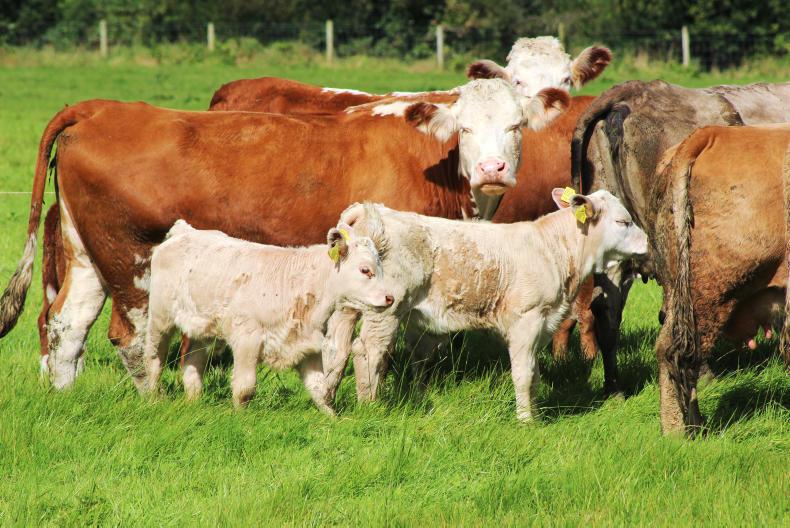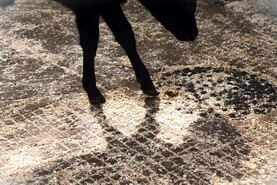Depending on where you are in the country, your opinion of the success of the grazing period so far in 2020 will vary greatly. While things got off to a poor start in early spring, grazing conditions have been excellent since.

Autumn calving cows and spring born weanlings on Barry Carty's farms.
While conditions remain very good, growth has been lower than average in most areas of the country in the last three to four weeks.
Much of the country received decent levels of moisture over the last few days and with rain forecast in all areas for the week ahead, it should result in a burst of growth in the coming fortnight.
The picture can change quickly in terms of grass supply, so acting now will help manage the situation over the next few weeks.
The challenge for farmers now is to manage the quality of the grazing sward over the next few weeks. Quality has really suffered on many farms, with a lot of seed heads and stem creeping into the sward.
When the burst of growth comes, it will allow corrective measures to be taken.
1. Measure grass
Step one has to be measuring grass. If you don’t know what you are growing, then you will not have the confidence to make any of the decisions in the following points. Start the routine of walking the farm at least once a week.
2. Apply nitrogen
Applying 25 to 30 units of nitrogen will aid grass supply and quality. When grass is stressed, it will put up a seed head to try to reproduce. Up to this point, moisture has been the limiting factor for growth; if this is corrected make sure that nitrogen does not hold things up.

Stronger paddocks that have had to be grazed up to this point should be taken out as surplus once grass growth rates increase.
3. Take out heavy covers
Strong covers that you may have been forced to graze up to this point due to low growth rates will be able to be taken out as surplus grazing.
4. Topping
There may also be a need for a round of topping following grazing to take the stem out of the sward for the next rotation. Where topping is being carried out, make sure you are cutting the sward below a 5cm residual height.

Creep gate to allow calves graze ahead of cows.
5. Creep graze
Spring-born calves are now at a stage where their grass intake is starting to become a significant proportion of their total diet. Raising the electric fence to allow calves to forward creep graze ahead of the cows will give them access to the best grazing on the farm, boosting liveweight gains.
Depending on where you are in the country, your opinion of the success of the grazing period so far in 2020 will vary greatly. While things got off to a poor start in early spring, grazing conditions have been excellent since.

Autumn calving cows and spring born weanlings on Barry Carty's farms.
While conditions remain very good, growth has been lower than average in most areas of the country in the last three to four weeks.
Much of the country received decent levels of moisture over the last few days and with rain forecast in all areas for the week ahead, it should result in a burst of growth in the coming fortnight.
The picture can change quickly in terms of grass supply, so acting now will help manage the situation over the next few weeks.
The challenge for farmers now is to manage the quality of the grazing sward over the next few weeks. Quality has really suffered on many farms, with a lot of seed heads and stem creeping into the sward.
When the burst of growth comes, it will allow corrective measures to be taken.
1. Measure grass
Step one has to be measuring grass. If you don’t know what you are growing, then you will not have the confidence to make any of the decisions in the following points. Start the routine of walking the farm at least once a week.
2. Apply nitrogen
Applying 25 to 30 units of nitrogen will aid grass supply and quality. When grass is stressed, it will put up a seed head to try to reproduce. Up to this point, moisture has been the limiting factor for growth; if this is corrected make sure that nitrogen does not hold things up.

Stronger paddocks that have had to be grazed up to this point should be taken out as surplus once grass growth rates increase.
3. Take out heavy covers
Strong covers that you may have been forced to graze up to this point due to low growth rates will be able to be taken out as surplus grazing.
4. Topping
There may also be a need for a round of topping following grazing to take the stem out of the sward for the next rotation. Where topping is being carried out, make sure you are cutting the sward below a 5cm residual height.

Creep gate to allow calves graze ahead of cows.
5. Creep graze
Spring-born calves are now at a stage where their grass intake is starting to become a significant proportion of their total diet. Raising the electric fence to allow calves to forward creep graze ahead of the cows will give them access to the best grazing on the farm, boosting liveweight gains.









 This is a subscriber-only article
This is a subscriber-only article











SHARING OPTIONS: